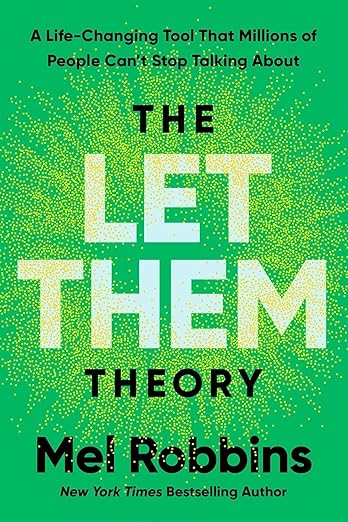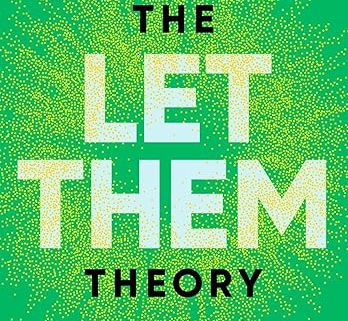In-Depth Review: The Let Them Theory: A Life-Changing Tool That Millions of People Can’t Stop Talking About by Mel Robbins
In-Depth Review: The Let Them Theory: A Life-Changing Tool That Millions of People Can’t Stop Talking About by Mel Robbins
By Nandy
Synopsis

The Let Them Theory by Mel Robbins is a liberating manifesto for anyone drowning in the modern obsession with control. At its core, the book offers a radical yet disarmingly simple philosophy: “Let them.” Robbins argues that much of human suffering stems from our compulsive need to manage others’ actions, opinions, and choices—a habit that drains energy, fuels anxiety, and stifles personal growth. Through a blend of neuroscience, psychology, and raw personal storytelling, Robbins teaches readers to release their grip on the uncontrollable and redirect focus inward.
The book is structured around two pillars:
- Let Them: Allow others to think, act, and live as they choose without resistance.
- Let Me: Take ownership of your responses, boundaries, and goals.
Robbins illustrates this framework with relatable scenarios—from workplace micromanagement to familial tension—and pairs them with actionable steps, such as journaling prompts and boundary-setting scripts. A standout example is the “Prom Story,” where Robbins’ daughter teaches her to relinquish control over her son’s plans, sparking the theory’s inception. The narrative crescendos with a rallying cry for self-empowerment: “No one is coming to save you. You must save yourself.”
While critics note the book’s occasional repetitiveness, its strength lies in its pragmatic immediacy. Readers report reduced stress, healthier relationships, and renewed clarity after applying its principles—a testament to its viral appeal on platforms like TikTok and Instagram, where Robbins’ explainer video garnered 1.4 million likes.
Author Background Mel Robbins
Mel Robbins is a #1 New York Times bestselling author, motivational speaker, and host of the globally acclaimed Mel Robbins Podcast. Known for her “no-nonsense” style and science-backed advice, she rose to fame with The 5 Second Rule (2017), a tool to combat procrastination that has been adopted by Fortune 500 companies and healthcare professionals alike.
Robbins’ credibility is rooted in her transparency about personal struggles, including financial ruin, career setbacks, and anxiety—a vulnerability that resonates deeply with her 19 million social media followers. The Let Them Theory marks her pivot from individual habit-building to relational dynamics, blending Stoic philosophy, Buddhist principles, and modern psychology. Notably, Robbins credits her daughter, Sawyer, as a co-author in later editions for her role in refining the theory’s real-world applications.
Oprah Winfrey hails the book as “one of the best self-help books I’ve ever read”, while Forbes praises Robbins as a “billion-view podcaster” who democratizes personal growth.
Critical Analysis The Let Them Theory
1. Strengths
- Simplicity Meets Science: Robbins distills complex concepts like radical acceptance and cognitive behavioral therapy into a two-word mantra. Neuroscience-backed chapters, such as “The Science of Letting Go,” explain how cortisol reduction and amygdala regulation align with the theory, making it accessible to self-help novices.
- Relatable Storytelling: The book thrives on raw, often humorous anecdotes. For example, Robbins recounts a meltdown at a slow-moving grocery store cashier, using the moment to model shifting from frustration to calm—a scene readers describe as “seeing my own life on the page.”
- Actionable Frameworks: The ABC Loop (Assess, Break, Choose) and Frame of Reference (understanding others’ motivations) provide tangible tools for navigating conflicts. A reader testimonial highlights how the ABC Loop helped her quit a toxic job without guilt.
- Workplace Wisdom: The chapter “At Work: Empower, Don’t Micromanage” offers life-changing advice for burnt-out professionals. One manager shared that adopting “Let Them” reduced team turnover by 40% by fostering autonomy.
2. Weaknesses
- Repetition: Some readers note that the 336-page length could be trimmed, as core ideas are revisited across chapters. However, fans argue the repetition reinforces mindset shifts, calling it “a manual to revisit, not a one-time read.”
- Systemic Blind Spots: While the theory excels in interpersonal scenarios, it struggles with systemic issues like discrimination. Robbins addresses this by urging readers to pair “Let Them” with “Let Me advocate,” though critics argue this lacks depth.
3. Themes and Symbolism
- Radical Acceptance vs. Empowerment: The book reframes acceptance as active empowerment, not passive resignation. Robbins writes, “Letting go isn’t about apathy—it’s about reclaiming your power.”
- The Illusion of Control: Drawing parallels to Stoicism, Robbins illustrates how chasing control sabotages joy. A haunting example: a woman who delayed launching her business for years due to fear of judgment, only to thrive after embracing “Let Them.”
- The “Let Me” Revolution: The second pillar transforms the theory from a coping mechanism to a life philosophy. Readers praise the shift from “Why won’t they change?” to “What can I create?” as revelatory.
4. Controversies
- Toxic Positivity Accusations: Critics argue the theory risks dismissing legitimate grievances, such as workplace harassment. However, Robbins clarifies that “Let Them” isn’t about tolerating harm but choosing responses that protect peace.
- Originality Debates: Some note similarities to ancient philosophies like Stoicism, but fans counter that Robbins’ modern spin—mixing neuroscience with Instagram-era relatability—makes it groundbreaking.
Reception and Cultural Impact The Let Them Theory
The book has sold 4 million copies and dominated bestseller lists in 15 countries, fueled by Robbins’ viral social media presence and Oprah’s endorsement.
- Praise: Readers call it “a lifeline for recovering people-pleasers” and “the permission slip I needed to quit overthinking.” Therapists like Gloria Zhang applaud its alignment with clinical practices, noting its use in treating anxiety disorders.
- Criticism: A vocal minority critiques its bootstrap undertones, arguing phrases like “No one is coming to save you” overlook systemic barriers. Yet even skeptics admit the theory’s utility in daily stressors.
- Cultural Moments: The book sparked the “Let Them Challenge” on TikTok, where users share stories of applying the theory to everything from divorce to career pivots.
Personal Opinion About Books The Let Them Theory
As someone who’s cycled through countless self-help books, The Let Them Theory stands out for its brutal yet kind honesty. I applied its principles during a family conflict: instead of arguing with a relative’s toxic comments, I said “Let them,” then “Let me prioritize my peace.” The result? A weight lifted—and a relationship salvaged by boundaries.
While the book isn’t flawless (I wish it addressed privilege more directly), its actionable heart overshadows gaps. The chapter “How to Love Difficult People” alone—which teaches empathy without self-sacrifice—is worth the price.
Publication Details The Let Them Theory
- Title: The Let Them Theory: A Life-Changing Tool That Millions of People Can’t Stop Talking About
- Author: Mel Robbins (with Sawyer Robbins in later editions)
- Publisher: Hay House Inc.
- Publication Date: December 31, 2024
- Pages: 336
- ISBN: 978-1401971366
- Genres: Self-Help, Psychology, Personal Development
- Content Warnings: Discussions of anxiety, burnout, and relational conflict.
Who Should Read This Book The Let Them Theory?
- Chronic Overthinkers: If you lose sleep over others’ opinions, this book is your antidote.
- Burnout Survivors: Perfect for those drained by workplaces or caregiving.
- Fans of Brené Brown: Lovers of Daring Greatly will appreciate Robbins’ blend of research and raw storytelling.
- Newcomers to Self-Help: Accessible language and bite-sized chapters ease readers into mindset work.
Conclusion About The Let Them Theory
The Let Them Theory isn’t just a book—it’s a movement. By trading control for clarity, Robbins hands readers the keys to a life unshackled from others’ drama. Is it a panacea for systemic injustice? No. But as a tool for everyday peace, it’s unparalleled.
Whether you’re navigating a toxic boss, a rocky relationship, or your own inner critic, this book offers a roadmap to reclaim your power. As Robbins writes, “You don’t have to set yourself on fire to keep others warm.” Let them shiver. Let you shine.
Rating: ★★★★ (4/5)
Recommendation: Buy it, dog-ear it, gift it to everyone you love. Pair with Radical Acceptance by Tara Brach for a deeper dive into self-compassion.
Further Exploration
- Listen to Robbins’ podcast episodes dissecting the theory.
- Join the “Let Them Challenge” on TikTok for community support.
- Explore Mike Rinder’s blog for nuanced discussions on balancing acceptance with advocacy.
Final Note: In a world obsessed with fixing, managing, and perfecting, The Let Them Theory is a revolutionary act of self-love. As one reader put it: “This book didn’t change my life—it gave me back my life.”
- Review Lost Girls: An Unsolved American Mystery by Robert Kolker
- Review: House of Earth and Blood by Sarah J. Maas
- Review: House of Sky and Breath by Sarah J. Maas
- Review: House of Flame and Shadow by Sarah J. Maas
- Review: Let Them Theory
- Review: Great Big Beautiful Life (Reese’s Book Club)
- Review: Sunrise on the Reaping
- Review: The Lost Bookshop



